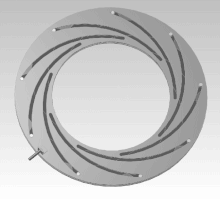Central locking

The central shutter (or lamellar shutter ; English central shutter or lens , leaf , blade , diaphragm shutter ) is one of the two common design principles for shutter in camera construction alongside the focal plane shutter . Another simpler type of closure without slats or curtains, between the central and focal plane shutter, is the single or double guillotine shutter or the leaf shutter for cheap cameras. A rotor or rotation lock is also possible .
A mechanical shutter is not absolutely necessary for a digital camera , an electronic shutter is used here . For example, the preview is generated on the display without the constant opening and closing of a shutter. Instead, the sensor is read out at a certain frequency and thus emptied in order to take a new image. Often the mechanical shutter is then only used to end the actual exposure so that no further charges arise from further incident light when the pixels are read out. Depending on the sensor used, this could lead to smearing or incorrect exposures.
The central shutter is typically located “centrally” in the lens between the lenses .
The central shutter consists of several lamellas grouped concentrically around the optical axis , which when the camera is triggered snap back synchronously from this axis and release the path of the light onto the film. In contrast to the iris diaphragm , which is constructed in the same way , the central shutter closes completely in the rest position, so no light can pass through the shutter curtain.
In the case of single -lens reflex cameras , however, the central shutter initially closes after it has been released, as all image settings were previously made with the aperture open . Then the mirror flips up and the central shutter opens again for the duration of the exposure and then closes again. The mirror then swivels back into the beam path and the film magazine is closed. Only now is the film transported (either manually or automatically) and the shutter opens again. This does not apply to the focal plane shutter, because it is behind the mirror, close to the film plane.
For optimal exposure , the central shutter must be positioned in the beam path like an aperture , otherwise there may be less exposure at the edge of the image.
In various cameras, such as the Minox 35 ML and the last Agfa Optima series of locks, the appropriately controlled central lock takes on both the function of the shutter and the function of the aperture. It is controlled electrically or electronically how far the shutter slats open.
While mechanically controlled central shutters such as panels usually have a larger number of slats, modern electrically or electronically controlled shutters can, depending on the design, manage with fewer with the same performance.
Advantages and disadvantages
Advantages of the central lock:
- Low shock and vibration, therefore less technical distortion of the camera.
- Usually quieter than the focal plane shutter.
- Allows uniform illumination of the entire negative (with correct positioning in the beam path). In contrast to the focal plane shutter , this largely applies to all subjects, apertures and exposure times.
- no blurring of the motif, as with the focal plane shutter due to speed or exposure time.
- Flash synchronization possible for all exposure times .
- In contrast to the focal plane shutter, it is useful for both large film formats and small cameras.
- A malfunction of the shutter usually only affects the affected lens and not the entire camera, so you can continue to work with a different lens.
- Aperture and shutter functions can be combined with appropriate control, which simplifies the design.
Disadvantages of the central lock:
- Exposure times shorter than 1/500 s (1/1000 s) (1/2000 s with Hasselblads XCD lenses) can only be achieved with greater effort because of the high acceleration required for the moving parts. With fast lenses, the limit is even longer times.
- In cameras with interchangeable lenses , a shutter is usually built into each lens. This results in higher costs per lens, the lens becomes heavier and requires a more complex construction, which also prevents or complicates a high light intensity (especially relevant for interchangeable lenses).
use
Large format and view cameras are actually only built with a central lock due to the design-related parameters.
In 35mm and viewfinder cameras , it is found in the vast majority of cameras for the same reason. A notable exception here are the Leica M and technically related cameras with interchangeable lenses. In the field of miniature - SLR is the central locking is only in individual special lenses are used (eg for portrait photography ).
In the medium format , both types of closures are about equally represented in the sub-professional sector again outweigh Central and Guillotinenverschlüsse.
Web links
- Detailed information about closures at kamera-geschichte.de.
- Setting up a camera on puchner.org, accessed on May 27, 2018.
- The shutter - controlling the exposure on scandig.info, accessed on May 27, 2018.



